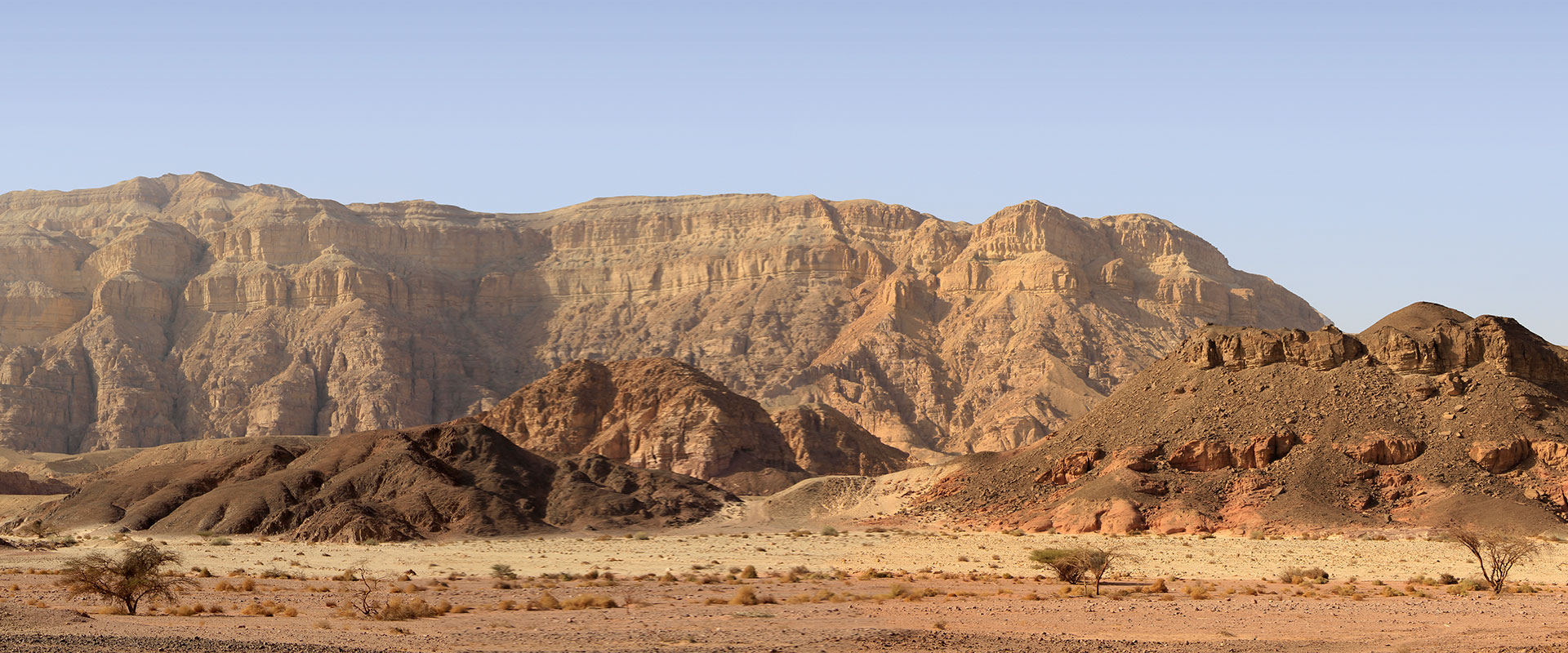The Desert of Negev is the real Land of Abraham. The Patriarch lives here most of his life in these incredible wilderness lands. Abraham, Yitzhak and Jacob pilgrims in the Land of Canaan but established theirs tends in the desert of Negev.
The people of Israel also pilgrim in this area along of fourth years before start the Conquest of the Land of Promise under Joshua's rules. The tribe of Simeon and Judah established here their cities.
“From there he went on toward the hills east of Bethel and pitched his tent, with Bethel on the west and Ai on the east. There he built an altar to the LORD and called on the name of the LORD.
Then Abram set out and continued toward the Negev.”
Genesis 12:8–9 NIV11-GK
NEGEB (Nĕg′ eb) or NEGEV (Nĕg′ ĕv) (preferred sp.) Place-name meaning “dry” referring to an arid region in southern Palestine and coming to mean “south.” During biblical times it was more populated than today indicating either more rainfall then or better conservation of the resources. It was the land of the Amalekites during Abraham’s day (Gen. 14:7). There he exiled Hagar (21:14). The Israelites wandered in the Negev after a futile attempt to enter Canaan (Num. 14:44-45). David incorporated it into his kingdom, and Solomon established fortresses in the region. Daniel used the term, translated “south,” to refer to Egypt (Dan. 11:15,29). After Judah fell in 586 B.C. Edom took the area into its kingdom. In NT times it was known as Nabatea.
“NEGEB or NEGEV,” Holman Illustrated Bible Dictionary, paragraph 12331.
The Patriarchs, whom many would place in the Middle Bronze Age, are reported to have sojourned in the Beer-sheba area. While MB remains have been uncovered at other Negeb sites, Beer-sheba has yet to reveal any significant MB remains. The wilderness wanderings center around the oasis of Kadesh-barnea, which lies on the western edge of the Negeb highlands. The Hebrews are also reported to have fought the Canaanites at Arad and Hormah (Num. 21:1-3; 33:40; Josh. 12:14). However, there has been little evidence found of any LB settlement in either the Beer-sheba basin or in the highlands; in the south, 13th-century copper mines have been excavated at Timna.
“NEGEB,” Eerdmans Dictionary of the Bible, 955.

With the monarchy, Negeb activity increased. Saul and David fought the Amalekites (1 Sam. 14-15; 30), and Solomon established a naval outpost at Ezion-geber (1 Kgs. 9:26). In the 8th century, Uzziah reinvigorated the Negeb, reestablishing the Ezion-geber trade. Transshipment of copper and other goods from Ezion-geber required the establishment of royal forts to safeguard the routes (2 Chr. 26:10). A latter 7th-century building boom can be attributed to either Manasseh or Josiah. In its final years, Judah increasingly lost control over the Negeb to the Edomites. Edomite names, ostraca, and cult sites appear throughout the Negeb (e.g., Qitmit).
Archaeological evidence from the Persian and Hellenistic period is almost totally absent. Written sources discuss the presence of the Nabateans, but few remains of these tent-dwelling people have been found. By the turn of the eras, the Nabateans had come into their own as spice traders and merchants. The Petra-ʿAvdat-Gaza road was built, along with caravansaries to guard the frankincense and myrrh route. Nabatean cities and forts were constructed, trade flourished, and agricultural projects were even introduced. Ultimately, the Romans annexed the Negeb and its highlands to Palestina Tertia. In the Byzantine era, the area experienced its greatest flowering. Cities expanded, churches were built, monasteries founded, and settlement increased.
“NEGEB,” Eerdmans Dictionary of the Bible, 955.

Abram would not become “a great nation,” as God had promised, during his lifetime. However, his descendants apparently numbered over two million by the time of the exodus (some 600,000 men, plus their wives and many children; Ex 12:37). Abram has become significant in history as the physical father of Israel and the one regarded as spiritual “father” by Jews, Christians, and Muslims. Abram became “a blessing” by his example of proper worship and proclamation of the Lord’s name (12:8), as well as by his justifying faith (15:6; Rm 4:3). His name may be reflected in a tenth-century B.C. Egyptian list of places in the Negev that includes “The Enclosure of Abram.”
Ted Cabal, ed., The Apologetics Study Bible, Nashville: Holman Bible Publishers, 2007, paragraph 711.


The blessing and curse here have played out repeatedly in history. The nations or groups (plural: “those”) who have blessed Abram or his descendants have been blessed by God. The individuals (singular: “him”) who have cursed Abram or Israel have been “cursed,” coming eventually to a bad end. This, however, is not a blank check for the actions of unbelieving Israel, as if the nation could do no wrong or deserves no criticism or has no accountability for its actions. It is a general ongoing promise. Acts 3:25 and Gl 3:8 indicate that all the families of the earth are blessed in the availability of salvation through Jesus Christ, and Gl 6:16 refers to the church as “the Israel of God” through which, by implication, that blessing is extended.
Ted Cabal, ed., The Apologetics Study Bible, Nashville: Holman Bible Publishers, 2007, paragraph 712.
In referring to “the people [Abram] had acquired in Haran” the Bible is not sanctioning slavery. “Acquired” may refer to household servants, which wealthy families of the era had, rather than to slaves. Furthermore, even characters whom the Bible views favorably do not always act in accordance with what God approves. In evaluating their actions, we must recall that God did not reveal His will in its entirety at the beginning, but rather gradually throughout the course of biblical history. Biblical narrative often conveys the divine and human authors’ evaluation of a character’s actions implicitly rather than explicitly, not by denouncing the actions but by recording their outcome. The disgrace resulting from Abram’s lie in verses 12–13 is an example of this.
Some have supposed the note “At that time the Canaanites were in the land” (see note on 13:7) means that in the author’s day they were no longer there. If so, Moses could not be the author. But “that time” is clearly not being contrasted to the author’s time but to Abram’s time. The point is that when God made His promise to Abram the land was already occupied.
Ted Cabal, ed., The Apologetics Study Bible, Nashville: Holman Bible Publishers, 2007, paragraph 713-714.


